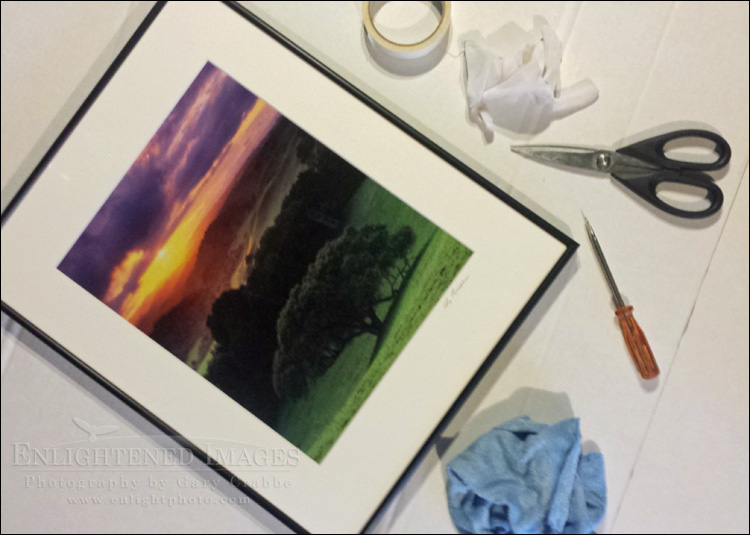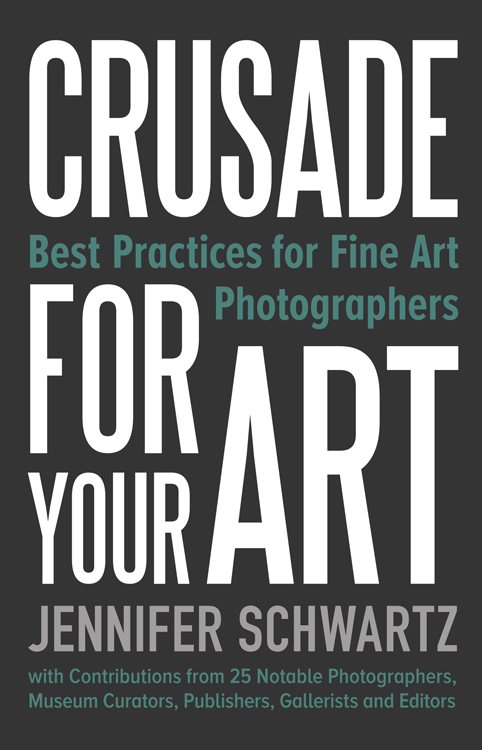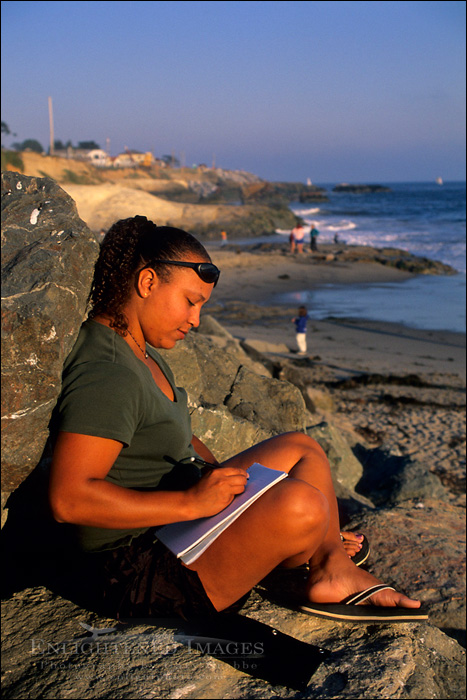Picture: Freshly framed fine art photographic print getting ready for shipment to a client.

I wanted to share with you this post about a book I recently had a chance to review. Crusade for Your Art – Best Practices for Fine Art Photographers is written by Jennifer Schwartz, and includes contributions from more than two dozen notable photographers, editors, publishers, and gallery directors. Jennifer is also the founder and Executive Director of CursadeforArt.org, a non-profit organization dedicated to connecting artists and their artwork together with new audiences. And while I don’t consider myself a true ‘Fine Art’ photographer, I’ve had enough experience selling fine art prints and dealing with a variety of galleries over my 25 years to feel like I have a pretty solid handle on what it takes to enter this niche of the art world.
 Crusade for Your Art – Best Practices for Fine Art Photographers is just over 100 pages of an easy to read, well-written guide to successfully entering the world of Fine Art Photography. It seems best targeted for those who have already developed a strong passion for photography as a medium, and those who are looking into avenues of creating and selling photographic works as fine art prints. The first third of the book addresses some of the very basic and primary considerations such as what it means to establish a body of work, editing that work, and then moving on to more technical aspects like identifying what choices can be made regarding sizing, whether you should do limited editions, and pricing your work. She also addresses some of the other important supporting aspects which will help to establish any artist like the need for a website and a presence on Social Media sites. The meat of the book is tailored to building a set of goals and venues for where your art can be marketed or presented. These cover the primary aspect approaches like looking for gallery representation, seeking out exhibit opportunities, entering contests, and looking for publication venues. The final ten percent of the book discusses various approaches and advice for turning a set of plans into action, along with specific steps you can take to get your work seen and noticed, including things like attending portfolio reviews. She also offers at the conclusion of the book several appendix resources that you can use to get your feet wet and walking down the path.
Crusade for Your Art – Best Practices for Fine Art Photographers is just over 100 pages of an easy to read, well-written guide to successfully entering the world of Fine Art Photography. It seems best targeted for those who have already developed a strong passion for photography as a medium, and those who are looking into avenues of creating and selling photographic works as fine art prints. The first third of the book addresses some of the very basic and primary considerations such as what it means to establish a body of work, editing that work, and then moving on to more technical aspects like identifying what choices can be made regarding sizing, whether you should do limited editions, and pricing your work. She also addresses some of the other important supporting aspects which will help to establish any artist like the need for a website and a presence on Social Media sites. The meat of the book is tailored to building a set of goals and venues for where your art can be marketed or presented. These cover the primary aspect approaches like looking for gallery representation, seeking out exhibit opportunities, entering contests, and looking for publication venues. The final ten percent of the book discusses various approaches and advice for turning a set of plans into action, along with specific steps you can take to get your work seen and noticed, including things like attending portfolio reviews. She also offers at the conclusion of the book several appendix resources that you can use to get your feet wet and walking down the path.
The Pros and Cons: As I mentioned earlier, Jennifer writes with a very clear and easy to read style, and the layout of the book facilitates that as well. There’s a lot of content here, and each bit is broken down into bite-sized bits. There are many instances where examples are given, or bullet point lists help provide clear and concise pointers or advice. Among the instances include examples of good and ‘not-so-good’ artist statements. In fact, I found the first less-than-ideal artist statement example to be particularly humorous; a clear play against the often over-used ‘art-speak’ that some artists are so fond of engaging as a device. Another fine example is the list of recommended items to include with exhibition proposals. I also especially appreciate the variety of other voices that she brings to the table by including relevant snippet of advice or tips from other leading professionals within the art and photographic arenas.
At the same time, one of the books strengths is also its greatest weakness. The fact that there is so much information served up in short, easy to read and digest fashion leaves one feeling as if the book is more of a comprehensive outline than a fully-detailed resource. Throughout the book there are many items or aspect which may be covered over the course of only a page or two, yet one might feel that entire books, if not much more fully-detailed chapters on those single items could have been written. One perfect example of this would be on the aforementioned section about sizing, pricing, and editioning of one’s work. We get an outline takeaway about the issues and considerations that an artist must employ, but it’s more like getting a taste of what a meal should be rather than getting stuffed on a full three or four-course service meal. My last critical thought was that the few resource appendix could have been a bit more thoroughly flushed out. For instance, there could have been a quick synopsis of the various online resources, as well as URL’s for the list of Photo Review Festivals. Finally, I think I would have enjoyed seeing an additional appendix containing a Further Suggested Reading List.
Also of very minor note, but something I kept catching myself on repeatedly are the transitions into the advice sections from the outside sources. It’s entirely clear within the text that you’ve transitioned into someone else speaking as these parts are all presented in italic text. The problem for me was that she ended the text with a de-facto signature line of who was speaking, and what position they held within the industry. From a reader’s and layout perspective, I kept wishing I had that information at the top of those sections before I started reading. Consistently I’d get about two or three lines into the text and find myself stopping, saying “wait…who is this, and why should I be caring what they have to say?” I’d then skip to the end of the section to find out who was speaking, and what their position was, as if to validate what I was reading, then I’d skip back to where I’d left off. By the end of the book, I felt as if I’d repeated that process nearly two dozen times.
 The Takeaway: Crusade for Your Art – Best Practices for Fine Art Photographers by Jennifer Schwartz is an excellent resource book for those looking to venture into the world of Fine Art Photography. There is a lot of good information and advice, and all of it clearly presented. The book is best suited to those just starting out in this area, and it will serve as an ideal outline for covering the important basics that one will need to be aware of when walking down the road of marketing or selling your fine art imagery. The book covers a lot of bases in very basic, straightforward language. You won’t get lost or overwhelmed, and you’ll walk away with a good, solid grasp of the many aspects needed to get out there and hit the pavement. It’s much like a starter’s football playbook designed to get you up and running, crusading for your own artwork. It’ll give you the lay of the field, the basics of how to play the game, and even a few suggested strategies. But that in itself is not the same as getting out there on the field and taking your share of hits along the was as you build up experience. If on the other hand, you’ve been out there already doing this for any number of years, you’ll probably find the book a bit too basic. However, I would be remiss not to say that you may still likely find a few good tips or bits of advice along the way, especially from some of the outside sources that have been brought into the fold.
The Takeaway: Crusade for Your Art – Best Practices for Fine Art Photographers by Jennifer Schwartz is an excellent resource book for those looking to venture into the world of Fine Art Photography. There is a lot of good information and advice, and all of it clearly presented. The book is best suited to those just starting out in this area, and it will serve as an ideal outline for covering the important basics that one will need to be aware of when walking down the road of marketing or selling your fine art imagery. The book covers a lot of bases in very basic, straightforward language. You won’t get lost or overwhelmed, and you’ll walk away with a good, solid grasp of the many aspects needed to get out there and hit the pavement. It’s much like a starter’s football playbook designed to get you up and running, crusading for your own artwork. It’ll give you the lay of the field, the basics of how to play the game, and even a few suggested strategies. But that in itself is not the same as getting out there on the field and taking your share of hits along the was as you build up experience. If on the other hand, you’ve been out there already doing this for any number of years, you’ll probably find the book a bit too basic. However, I would be remiss not to say that you may still likely find a few good tips or bits of advice along the way, especially from some of the outside sources that have been brought into the fold.
Disclosure: The book title link in the first paragraph or clicking on the book cover itself will take you to where you can buy the book on Amazon.com. There is no affiliate link, and I don’t make a dime if you choose to buy the book, or even if you click on the link. This is a 100% unsponsored, affiliate-free review.
—
![]()
If you like this post , I would greatly appreciate it if you’d consider sharing this with your friends using one of the Social Media sharing buttons located at the top of this post. You can also sign up to receive free updates by email when future posts are made to this blog.
![]()
—
Gary Crabbe is an award-winning commercial and editorial outdoor travel photographer and author based out of the San Francisco Bay Area, California. He has seven published books on California to his credit, including “Photographing California; v1-North”, which won the prestigious 2013 IBPA Benjamin Franklin Gold Medal award as Best Regional title. His client and publication credits include the National Geographic Society, the New York Times, Forbes Magazine, TIME, The North Face, Subaru, L.L. Bean, Victoria’s Secret, Sunset Magazine, The Nature Conservancy, and many more. Gary is also a photography instructor and consultant, offering both public and private photo workshops. He also works occasionally a professional freelance Photo Editor.

Ordered, thanks for the great review 🙂
Ditto, what the other Bill said 🙂
Thank you Gary for the review – most helpful! FYI Arizona based photographer Alain Briot has a similar book too.
Be well.
Frederic in Montréal,
Canada